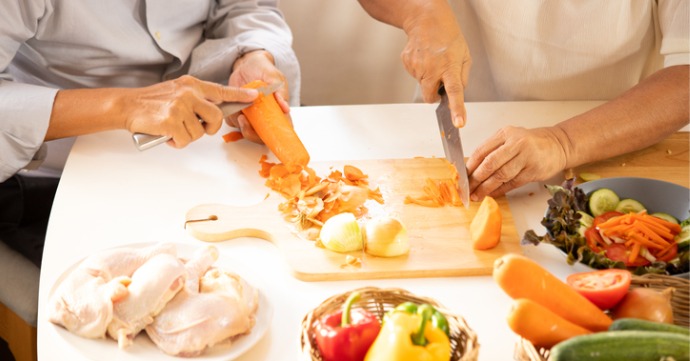
An estimated 4.1 million Australians are struck down with food poisoning each year. This resulted in over 31,000 hospitalisations and 86 deaths. Sadly, most of these cases could have been avoided. Find out how food becomes contaminated by germs, viruses, and bacteria and how to prevent it.
What is Food Contamination?
All food can be contaminated. Food contamination is the presence of chemicals or microorganisms in food that can make a person sick. The illness may develop within a few days in the case of bacteria and viruses or slowly build up over years due to consuming low levels of chemicals frequently.
Types of Food Contaminations
#1 Poor Food Handling Practice
Food handlers can unwittingly contaminate foods in several ways. Poor food handling can cause serious illness and even death in immune-compromised people. If a food handler has a vomiting or diarrhoea infection, they can contaminate the food and pass it on to anyone who consumes it.
Hand hygiene is one of the most important aspects of food handling. If a food handler touches a contaminated surface, germs and viruses can transfer from their fingers to the food. Bacteria from the bathroom can contaminate food if hands aren’t washed properly. Sneezing or coughing near food can also cause contamination. Pathogen in an uncovered wound is also another common source of possible food contamination.
#2 Cross-Contamination of Foods
Certain cooked and raw foods shouldn’t come into contact with each other during storage and preparation. Using the same knife or cutting board with salad ingredients after touching raw chicken can cause germs to contaminate the salad. The knife and board need washing with detergent and hot water after handling the raw chicken, but ideally, the utensils for fruits and vegetables should be separate from the knives and cutting board(s) for raw meat. Lastly, meats need to be stored carefully in the fridge to ensure they don’t touch or drip juices onto other foods.
#3 Food Temperature
Some foods are at risk of being spoiled if they aren’t kept at the right temperature. In simple terms, cold food should be kept cold and hot foods should be kept hot so bacteria doesn't increase to unsafe levels.
Cold foods should be kept at 5°C or less, and hot food foods should be kept at 60°C or hotter. Frozen foods should be stored at -15°C or colder and defrosted in the fridge, not on the kitchen bench. High-risk foods not stored at the correct temperature can allow bacteria to multiply to dangerous levels. The highest-risk foods include raw and cooked meat, dairy, seafood, cooked rice, eggs, and prepared salads.
#4 Undercooked Foods
When foods aren’t thoroughly cooked bacteria can be present at dangerous levels. Particular attention should be paid to high-risk foods including chicken, meat, and seafood, and ensuring these are always properly cooked to reduce the risk of dangerous bacteria.
#5 Chemical Contamination
Foods can become contaminated by chemicals from a range of sources. Fruits and vegetables are often sprayed with a pesticide or fungicide while in the field or orchard. They need to be washed thoroughly to ensure harmful levels of chemicals are removed. Washing also removes animal manure and fertiliser.
Food preparation equipment and fittings need a thorough cleaning to keep foods safe. The chemicals for cleaning machinery and surfaces should never be ingested - equipment needs rinsing to ensure all traces of the chemical are removed before coming into contact with food.
Tips to Preventing Food Contamination
Food contamination can happen in the home and commercial kitchens. Prevention can be as simple as diligent hand washing and following the rules of safe food storage and preparation, but some tools can help protect against food contamination even further.
Germs and viruses can enter commercial food preparation premises on workers’ clothes and shoes. Covering personal clothing and shoes ensures staff don’t bring in high levels of bacteria, viruses, pet hair, dust and pollen which can contaminate the food.
Shoe Covers
Shoes worn by workers on the way to work get covered in bacteria. If the same shoes are taken into the food processing and manufacturing plants, there is a risk of food contamination. Covering shoes means workers can wear their protective footwear to work without the need to change them. Our hybrid waterproof overshoe is perfect for food preparation areas because the heavy-duty outside layer acts as a moisture barrier. Load the covers into an automatic shoe cover dispenser to ensure workers don’t touch their shoes while applying.
Hand Hygiene
Food handling staff should be diligent about hand washing before coming into contact with food. Correct hand washing procedures include washing under running water with soap for at least 20 seconds. Hands should be washed before, during, and after preparing food.
Safe Cooling
Perishable foods shouldn’t stay out of the fridge for longer than 2 hours as harmful germs can grow. Large quantities of casseroles, roasts, and stew that may not cool within two hours should be divided into smaller containers before storing in the fridge or freezer.
Cooking Food Thoroughly
A food thermometer can be used to check the internal temperature of food to ensure the food is cooked inside. Cooking food thoroughly is important to kill harmful bacteria. A few other rules of thumb include; avoiding shortening cooking times given on package labels or cooking books, reheating cooked food only once until piping hot, and serving food immediately once it's cooked or keeping it hot until serving.
For more information on Food Production and how you can further prevent food contamination, get in touch with Helix Solutions on 1300 29 32 32 or contact us online.